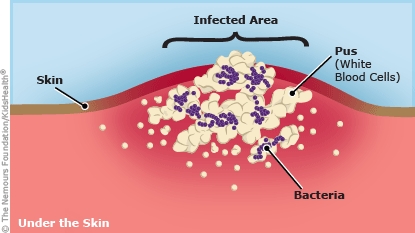- Parents Home
- Para Padres
- A to Z Dictionary
- Allergy Center
- Asthma
- Cancer
- Diabetes
- Diseases & Conditions
- Doctors & Hospitals
- Emotions & Behavior
- First Aid & Safety
- Flu (Influenza)
- Food Allergies
- General Health
- Growth & Development
- Heart Health & Conditions
- Homework Help Center
- Infections
- Newborn Care
- Nutrition & Fitness
- Play & Learn
- Pregnancy Center
- Preventing Premature Birth
- Q&A
- School & Family Life
- Sports Medicine
- Teens Home
- Para Adolescentes
- Asthma
- Be Your Best Self
- Body & Skin Care
- Cancer
- Diabetes
- Diseases & Conditions
- Drugs & Alcohol
- Flu (Influenza)
- Food & Fitness
- Homework Help
- Infections
- Managing Your Weight
- Medical Care 101
- Mental Health
- Nutrition & Fitness
- Q&A
- Safety & First Aid
- School, Jobs, & Friends
- Sexual Health
- Sports Medicine
- Stress & Coping
Skin Abscesses
Also called: Boil, Carbuncle, Furuncle
What Is a Skin Abscess?
A skin abscess is the body's way of trying to heal from an infection. It can form after germs, usually bacteria, get into a cut in the skin and cause an infection.
When bacteria get into a cut, the body's immune system sends white blood cells to fight the infection. It's these white blood cells that can collect and make pus. If pus collects and can't drain out, the area forms a painful abscess.
What Causes a Skin Abscess?
Usually, the infection is caused by a type of staph bacteria. Staph — short for Staphylococcus (staf-uh-low-KAH-kus) — bacteria live on the skin. Staph aureus and MRSA (methicillin-resistant Staph aureus) are the most common bacteria that cause abscesses.
What Are the Signs & Symptoms of Skin Abscesses?
Skin abscesses usually are red, swollen, and warm to the touch, and might leak fluid. An abscess that forms in the surface of the skin might look like an unhealed wound or a pimple. An abscess that forms underneath the skin may create a swollen bump. The area can be painful and tender.
In the most severe cases, the infection can cause fever and chills.

How Are Skin Abscesses Treated?
Abscesses get better after they open and the pus drains out. Applying a warm compress can help that happen. To make a compress, wet a washcloth with warm (not hot) water and place it over the abscess for several minutes. Do this a few times a day. Always wash your hands well before and after touching the abscess.
If a skin abscess doesn’t drain on its own, call your doctor. Sometimes skin abscesses need to be drained by the doctor. The doctor will apply a numbing medicine, then make a tiny cut in the top of the abscess to let the pus drain out. The cut is left open to drain and then heal on its own. Some abscesses get treated with antibiotics too, but this isn't always needed. If your child needs to take antibiotics, make sure to give all the doses as directed, even if they feel better. This is the best way to kill all the bacteria.
Make sure your child avoids touching, pushing, popping, or squeezing the abscess because that can spread the infection to other parts of the skin, making things worse.
When Should I Call the Doctor?
Call your doctor if:
- Your child's abscess doesn't drain after a few days of warm compresses.
- The abscess becomes more painful, swollen, and red.
- Red streaks develop around the infected area.
- Your child has a fever or chills.
- Your child is suddenly getting sicker or feels more tired.
Can Skin Abscesses Be Prevented?
If someone in your house has a skin abscess, prevent the spread of infection by not sharing clothes, towels, washcloths, sheets, or anything else that may have touched the abscess.
Good hygiene is the best way to avoid infection. Keep all cuts and wounds clean, dry, and covered with a bandage to protect them from germs.
Teach kids to wash their hands often and well, using soap and water for at least 20 seconds. If soap and water aren't handy, it's OK to use alcohol-based instant hand sanitizers or wipes.